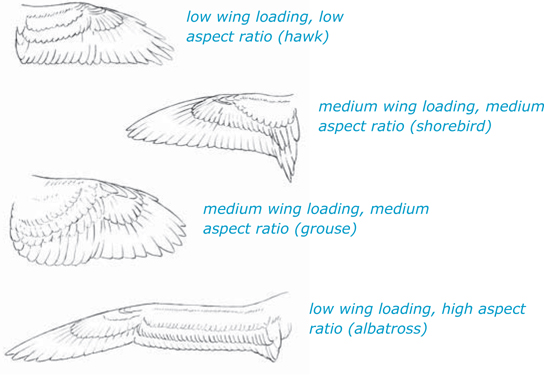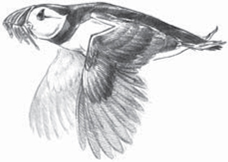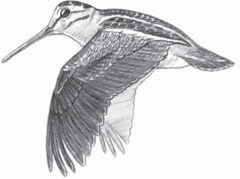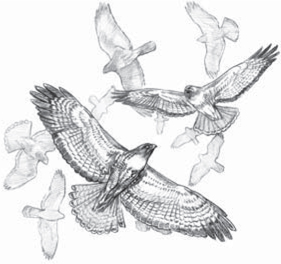
Who among us hasn’t wondered at, and perhaps even envied, the shape-shifting robin that one moment is hopping, two-legged, on the lawn and then suddenly jumps up, opens its wings, pulls in those legs, and flies! In eighth-century Spain, Abbas Ibn Firnas studied the dynamics of bird flight and carried out his own flying experiments. In sixteenth-century Italy, Leonardo da Vinci invented several flying machines, again closely studying the movements of birds.
Now we can take a jet to just about anywhere in the world, a feat impossible but for the inspiration and understanding of physics that came from looking at birds. But well over a millennium after the first human efforts at flight, we still watch flying birds with wonder.
Q How can birds stay up without flapping their wings?
A Depending on the shape of the wings, some birds must flap to stay aloft whereas some can glide or soar without flapping at all for many minutes or even hours.
Bird wings are shaped to form an airfoil. When a bird moves forward through the air, the shape and curve of the wing cause the air to flow faster above the wing than below it. The faster air above lowers the pressure (drawing the bird upward) while the slower air below raises the pressure (pushing the bird upward). This force holding the bird up is called lift, and it requires that the bird be moving forward or facing into a fairly stiff wind.

In order for a bird to soar rather than to flap, its weight must be low relative to the surface area of the wings and tail, giving it a low wing loading. Birds with low wing loading include cranes, hawks, vultures, anhingas, pelicans, and many others. Loons are an example of birds with high wing loading — that is, their body weight is very high relative to the surface area of their wings. If a loon is missing just a couple of flight feathers, flight becomes difficult or impossible. Penguins have such extremely high wing loading that their small wings can’t get them off the ground at all. Hummingbirds and many songbirds have high wing loading and must keep flapping to stay aloft.
The shape of the wings determines how a bird soars. An albatross, with its extremely long, slender wings, has a high aspect ratio, which allows it to fly at high speeds at low altitudes (sometimes barely above the ocean’s waves), while being extremely maneuverable. A condor’s wide, slotted wings give it a low aspect ratio. Birds with a low aspect ratio are adapted to slow speed, high altitude, effortless flight. Birds such as these, with aspect ratios at either extreme, may have difficulty taking off from the ground without facing a stiff headwind. Most soaring birds fall somewhere between these extremes.
Q How can owls fly so silently?
A Given their body size, owls have very large wings, allowing them to flap more slowly than many birds, reducing noise. The velvety surface of their flight feathers, along with their fluffy body plumage, helps absorb sound waves. The velvety surface also muffles any scraping sounds as the feathers slide against each other in flight.
But the one feature that is probably most significant in creating an owl’s silent flight is the stiff, comblike fringe along the edge of the outer vanes of certain wing feathers, the first primary feathers. This softens the contact between the air and the leading edge of the wing, essentially breaking up the whoosh of a wing beat into 50 or 100 tiny whooshes.
Birds are masters of flight, and because we can easily see their wings and feathers, many people assume that those are the key features that enable birds to fly. But birds are actually built for flight on the inside, too, including their skeletons. The bones of birds are exceedingly light: most flying birds have skeletons that weigh just half or a third of the weight of their feathers. Flying birds have huge airspaces in many or most of their bones, although some bones in each bird are filled with enough bone marrow to manufacture blood cells. The long wing bones of vultures and swans are hollow enough that in earlier times they were made into primitive flutes, which have since been recovered from caves. Charles Darwin had a pipe whose stem was made from the hollow wing of an albatross.
Many of the avian bones that are equivalent in origin to human bones are reduced and fused into forms unlike our own. For example, the bones corresponding to our finger bones have been fused and modified to support all the primary flight feathers. Birds also have some vertebrae that are fused together to form a rigid plate of bone that widens laterally to fuse with the pelvic bones. The entire structure makes a light, stiff framework that allows a bird’s legs to support its body with a minimum of heavy muscles.
Flying birds have a huge, keel-shaped sternum protecting the chest and part of the belly from physical blows while providing a perfectly placed surface for attaching the large wing muscles. The backbone, ribs, and sternum together form a flexible but strong box, housing and protecting the heart, lungs, and other major organs.
Some birds such as woodpeckers and blackbirds may cruise forward on a powerful flap or two and then soar for a moment, wings folded, before the next flap. This gives them an undulating flight pattern.

Q Flying seems like such a great thing. So why can’t Ostriches and penguins and some other birds fly?
A Flying is a splendid ability, but it comes at a cost in terms of maintaining a huge keel on the sternum and large flight muscles. Most ratites, the group to which Ostriches belong, seem to have lost flight in order to increase their body size and the strength of their legs and feet. They can outrun most predators, and some can kick hard enough to disembowel dog-sized predators.
Penguins do have strong wings and strong pectoral muscles to power them. In a sense, they really do fly, except it’s through water rather than air. Penguin bodies are streamlined as if for flight, which allows them to cut through the water with the least resistance.
But the requirements for rapid, powered swimming are different from those for flying. To dive deep and do the things penguins do in the water, and to survive the frigid air temperatures that many of them must endure, their bodies have huge fat supplies, heavy muscles, and extremely dense (and heavy!) feathers. That makes them too heavy to fly with such small wings.
Q If penguins, which all live in the Southern Hemisphere, are so good at flying underwater, why haven’t any northern birds, such as loons or puffins, lost their ability to fly?
A This may be because Antarctica and nearby islands provide low, safe places for penguins to nest, while Arctic islands are steep-sided, so oceanic birds in the north had to nest on more inaccessible cliffs. Only one Northern Hemisphere marine species lost the ability to fly: the Great Auk. This bird nested only on two or three low islands and became extinct in the midnineteenth century.

Q Do birds sleep while in flight?
A There’s evidence that some birds, especially longdistance migrants and swifts, may occasionally sleep in flight. Birds and marine mammals are the only warm-blooded animals we know of that have “unihemispheric slow-wave sleep” — that is, one side of their brain may sleep while the other half is awake. Marine mammals apparently do this so they can continue to swim and rise to the surface to breathe as they sleep. Birds on the ground can sleep with one eye open, instantly reacting to a predator’s approach. This ability may also allow them to sleep on the wing, which would be a handy skill for long-distance flights, although so far no one has proven this using brainwave monitoring, either under laboratory conditions or in nature.
Q How high can birds fly?
A The highest documented bird flight was of a group of Bar-headed Geese seen and heard crossing the Himalayas from India to central Asia at 29,000 feet (8,839 m). A Mallard was struck by an airplane over the Nevada desert at an altitude of 21,000 feet (6,400 m). Tiny Blackpoll Warblers sometimes migrate as high as 21,000 feet on their 2,300-mile (3,700 km) nonstop journey over the Atlantic Ocean. As far as we know, this is the longest flight, both in distance and time, and the highest nonstop flight, of such small birds.
HOW LOW CAN YOU GO?
 Observers at lighthouses and other vantage points note that certain migrants commonly travel at altitudes of a few feet to a few hundred feet above sea or land. Sandpipers, Red-necked Phalaropes, pelicans, and various sea ducks have been seen flying so low they were visible only as they topped the waves.
Observers at lighthouses and other vantage points note that certain migrants commonly travel at altitudes of a few feet to a few hundred feet above sea or land. Sandpipers, Red-necked Phalaropes, pelicans, and various sea ducks have been seen flying so low they were visible only as they topped the waves.
Radar observations indicate that birds on long-distance flights move along at higher altitudes than short-distance migrants. Advantageous tail winds of greater velocity are found higher up, along with cooler air that helps birds dissipate the heat they generate under the exertion of flying.
Q What’s the fastest bird? The slowest?
A The fastest bird may be the Peregrine Falcon, which has been clocked with various tools, including police radar, going at least 180 miles per hour (290 km per hour) and perhaps over 200 mph (322 kph). No one has clocked the White-throated Swifts that have successfully eluded peregrines — they’re certainly slower than a diving peregrine but are great at evasive maneuvers.
If we count the slowest bird as one that can remain in flight for many minutes going zero miles per hour, I suppose we could give that distinction to various hummingbirds. If we count the slowest bird beating its wings in forward flight without stalling out, American Woodcocks and Eurasian Woodcocks have both been clocked at just 5 mph (8 kph) in courtship flights. But American Woodcocks don’t always fly so slowly; they’ve also been clocked at 13 mph (21 kph) and even 42 mph (68 kph).

Q How far can a bird fly without resting?
A In terms of normal migration, flight distance depends on the species. Many Ruby-throated Hummingbirds take off from the Texas and Louisiana gulf coasts and fly nonstop to the Yucatán Peninsula, a minimum of almost 600 miles (965 km) with nowhere to rest or feed en route. Blackpoll Warblers migrate over the Atlantic Ocean from the northeastern United States to Puerto Rico, the Lesser Antilles, or northern South America. This route averages 1,864 miles (2,999 km) over water, sometimes requiring a nonstop flight of up to 88 hours. To accomplish this flight, the Blackpoll Warbler nearly doubles its body mass before the trip and takes advantage of a shift in prevailing wind direction to direct it to its destination.
The longest nonstop flight ever recorded for a bird wearing satellite tags was a female Bar-tailed Godwit, a shorebird that flew 7,145 miles (11,496 km) from Alaska to New Zealand without taking a break for food or drink during the nine-day journey in October 2007.

 Radar studies have shown that nocturnal migrants, including most songbirds, fly at different altitudes at various times during the night. These birds generally take off shortly after sundown and rapidly reach maximum altitude. They remain high until about midnight, at which point they gradually descend until daylight. There is considerable variation, but most small birds appear to migrate at between 500 and 1,000 feet (152–305 m). Some nocturnal migrants (probably shorebirds) fly over the ocean at 15,000 or even 20,000 feet (4,572–6,096 m). Nocturnal migrants also fly slightly higher than diurnal migrants.
Radar studies have shown that nocturnal migrants, including most songbirds, fly at different altitudes at various times during the night. These birds generally take off shortly after sundown and rapidly reach maximum altitude. They remain high until about midnight, at which point they gradually descend until daylight. There is considerable variation, but most small birds appear to migrate at between 500 and 1,000 feet (152–305 m). Some nocturnal migrants (probably shorebirds) fly over the ocean at 15,000 or even 20,000 feet (4,572–6,096 m). Nocturnal migrants also fly slightly higher than diurnal migrants.
Q Hawks are supposed to be solitary, but I saw a whole flock of them migrating. Do they band together for protection?
A Most hawks aren’t gregarious. But during migration, many species, particularly the buteos (the group of hawks that are often seen “making lazy circles in the sky,” as in the song “Oklahoma”), seek out rising columns of air called “thermal air currents” and “updrafts.” When a hawk feels one of these air currents, it widens its wings and tail to provide maximum surface area and begins circling as the air column carries it up in a spiral.
The hawk climbs as high as the air will carry it, then pulls its wings back in something of an arrow shape, and glides forward in the direction it’s migrating. Now it’s steadily losing altitude, but it may cover quite a distance before reaching treetop height; and meanwhile, on a good day, it’s found another thermal or updraft. Gliding between these rising currents can allow a hawk to cover hundreds of miles in a single day while using a minimum of energy.
A hawk may cover considerable ground seeking out thermals and updrafts, although experienced birds learn to search near shorelines and above pavement for a thermal, where the temperature is at least a few degrees warmer than nearby water or vegetated ground, causing the warmer air to rise, or to search near bluffs and tall buildings for an updraft, because such obstructions force oncoming winds upward. Air currents are invisible, but hawks can easily see exactly where a thermal or updraft is by watching for other hawks spiraling upward. They are drawn not to the other hawks but to the rising air. Over time on a sunny morning, hundreds or thousands of hawks can be seen spiraling on the same thermals.

SEE ALSO: pages 71 and 218 for more on hawk migration.
Q Why do geese fly in a V?
A There are two advantages to a V formation. The first is aerodynamic. As a single goose flaps through the air, it disturbs the air by creating wingtip vortices. These vortices are generally undesirable because they create a downwash that increases drag on that wing. However, this downwash is also accompanied by an upwash that can help a bird flying behind and slightly above it, providing lift and reducing drag. This means that the second bird doesn’t have to flap as hard or often to maintain the same speed as the first.
Although the birds trailing the first bird benefit most, the first bird also saves energy by having birds flying behind it, because their presence helps dissipate the upwash. In a long V, the birds saving the least energy are the one in front and the two pulling up the rear. That’s why birds flying in formation shift positions fairly often. In one study, researchers monitored pelican heartbeats as the birds flew. They found that the heart rates of pelicans flying in formation were much lower than those of pelicans flying alone.
The second reason birds fly in a V is for the same reason that Air Force jets do — to more easily maintain visual contact with one another.
Q Every now and then when I’m going through farm country, I see a huge flock of songbirds wheeling through the air in what looks like a big black cloud. What are they, and why do they fly that way? How come they don’t crash into each other?
A You’re looking at a flock of European Starlings, famous the world over for that wondrous flying. When they get into that amazing flock formation, chances are there’s a hawk nearby. Hawks are reluctant to get too close to one of these swarms, partly because of the unpredictable changes of direction the birds make and partly because the birds are so close together that the hawk risks colliding with one while grabbing another.
How do the birds within one of these swarms avoid each other? There are still mysteries involved, but we do know a few things thanks to high-speed photography, which allows us to slow the action. Birds seem to key in not on their immediate neighbors but on more distant birds, so the smoothness in changes happens the same way sports fans produce a “wave,” by watching the people more in the distance and anticipating the right moment to act. No particular bird in a swarm is the leader. Any individual can begin a new maneuver, banking toward the center of the group, and that movement spreads through the flock like that wave.